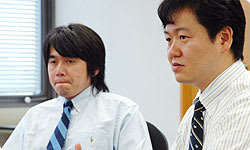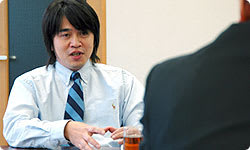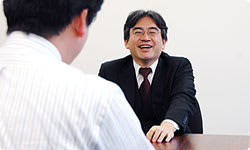Listening to Many Voices
Last year at the release of Wii, a lot of people were asking for a 3D Mario release. When the GameCube was released, there definitely were people saying that if Super Mario Sunshine4 was released at launch, things may have been different. I think Mario is a software that is burdened with such destiny. This time, Super Mario Galaxy will be released 11 months after the launch of Wii; please tell me, what did you struggle with?
| *4 | Super Mario Sunshine was a Mario 3D action game that was released for the GameCube in July 2002. (August in North America) |
Last year at the E3 event5 held in the US, we unveiled Super Mario Galaxy for the first time. At that time, Miyamoto-san announced that it would be released within 6 months after the Wii’s launch. When that was announced, I thought to myself, "we’ll be fine".
| *5 | E3 is a game show held annually in Los Angeles. Super Mario Galaxy was first announced here on May, 2006. |
But, that was not the case.
Correct. I truly apologize to our customers who have been anticipating this game coming out for so long. But with this being the latest addition to the long awaited 3D Mario game, we felt so strongly about this game, that we were unable to have our fans play it unless we were able to adjust any and all elements that we weren’t fully satisfied with. So it was important to try and release this simultaneously with Wii’s launch, but we also felt that it was much more important to make a game the customers would feel was really worth buying. We were so determined, that we even thought of closing down the Tokyo office if Super Mario Galaxy received poor reviews.
And so you decided to have a substantial number of play testers. Why did you decide to have so many?
The reason that we wanted to have a lot of play testers was our experience when making Jungle Beat. This game was on the show floor during the Nintendo World6 that was held in 2004. Carefully observing the visitors at this time, we implemented what we learned to fine tune the game at its final stages of the development cycle. As a developer, I was able to learn what you have to think about in certain areas of the game. For Super Mario Galaxy, I wanted to utilize inputs like these to their fullest extent.
| *6 | Nintendo World was a hands-on event held by Nintendo on November 2004 in five locations throughout Japan. |
Do you think 3D action games require more testing than other game types?
Actually, there was a time when I thought it might be impossible to make a 3D action game that would be so accessible, anybody could easily pick it up and enjoy the experience. When you’re playing on a 3D plain, it’s so easy to lose track of where you are in the field. And if the camera moves automatically, there are people that would get 3D sickness. So during the development of Super Mario Sunshine, we prepared several different camera modes that the players can choose from. However, this burdened the players with an additional task; they had to decide on the camera angle before they could go into gameplay.
Do you regret the decision?
I do. So for our next game, the side scrolling action game Jungle Beat, we made the camera angle automatic, where the player did not have to worry about the camera angle at all. But by doing that, we just ignored the underlying problem with camera angles in 3D action games, and did not do anything to solve the problem.
In Jungle Beat, you were able to change the way it looked, but that didn’t eliminate the problem that remained. Super Mario 647, which Koizumi-san was a part of the development team, was a game that was praised highly. But at the same time, it created a group of players that felt 3D games were too difficult for them. So the problem that was created then was left to be dealt with later?
| *7 | Super Mario 64 was the first 3D Mario action game that was released simultaneously with the Nintendo 64 console. Released June 1996. (September in North America) |
It was like turning away from the real problem. So for Super Mario Galaxy, I wanted to take on this difficult problem, that was present within 3D action games, upfront. This is why I felt it was necessary to listen to as many of the play testers’ opinions as possible.
So we had quite a number of people play test Mario Galaxy, and in a sense, I feel like I was one of those play testers myself. Of course we had Miyamoto-san sample it quite a bit. But there is one thing that is absolutely different from Miyamoto-san and myself, and that is the fact that I’m the type that gets 3D motion sickness.
Someone that gets motion sickness is the producer! (laughs)
Every time a sample was ready to go, I would take that to Shimizu-san so he could try it out. When he said, "no, I’m getting dizzy", I would say "Ok, I’ll fix it right away".
Truly, a living 3D sickness sensor! (laughs)
Yes, so I stuck to my role as the sensor. When Miyamoto-san came along and said "you need to make the camera angles more extravagant", I replied "but if you do, then I get nausea". However, the problem is that he rarely listens to what I say. Of course, when he hears one of the play testers saying, "I get sick, here", then he’ll say, "Ok, let’s fix it!" (laughs)
Miyamoto-san must think the customers’ opinions are the utmost important; more so than one of his fellow employees.
The thing is, everybody’s different, so the camera angle he used is nothing more than an angle that makes it harder to get motion sickness. We can’t say that people will never get nausea from it.





